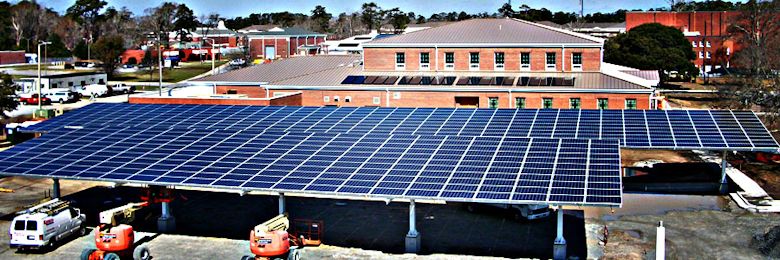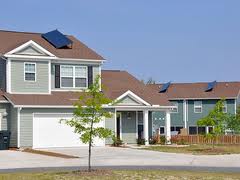 This is one of 17 solar arrays that officials plan to erect at Camp Lejeune. Photo: Advanced Solar Photonics |
JACKSONVILLE — In a city that is home to the largest Marine Corps base on the East Coast, caravans of Humvees carrying helmet-clad Marines are often spotted in the mix of traffic on Jacksonville’s roads.
Low-flying helicopters from nearby Marine Corps Air Station New River, distant pop, pop, pop sounds from Marines firing rifles and earth-shaking booms from large-caliber rounds fired at the bombing range in southeastern Onslow County – it’s part of life residents here get accustomed to.
Supporter Spotlight
But there’s something locals aren’t used to seeing that catches the attention of passers-by traveling on N.C. 24 by the entrance to Camp Johnson, home to the Corps’ combat service support school – a field of solar panels.
These sun-catching, energy producing photovoltaic panels mark the latest milestone in the Marine Corps’ green efforts and a Department of Defense initiative to use alternative energy.
Camp Lejeune began installing photovoltaic cells, or PVs, in 2009. Each panel is about 2.5 feet wide by 5 feet long. They’re made primarily out of silicon and covered in a protective glass coating durable enough to withstand debris such as tree limbs.
If a cell is cracked, it is still able to produce electricity, explained Navy Ensign Walter Anderson, Camp Lejeune’s assistant public works officer.
PVs capture sunlight and convert the sun’s energy into electricity. That electricity is then transferred either directly to a building or to the base power grid.
Supporter Spotlight
Several barracks already use energy generated from panels.
About half of the 17 PV sites the base plans to construct are up and running. Panels are spread out in fields like the one on Camp Johnson, placed on rooftops and even used as canopies over parking lots on base.
The PV site near Camp Johnson’s gate should produce about 1 megawatt, Anderson said. That’s enough energy to sustain more than 100 homes.
“Once everything’s completed we’re going to have over 14 megawatts of PV here,” Anderson said. “A big part of that is reducing overall the energy we use.”

More than 1,000 solar panels cover parking spaces to maximize space. The panels provide electricity and 8,000 gallons of hot water a day to the mess hall. Photo: Baker Renewable Energy
The defense department’s goal is to create 25 percent renewable energy by 2025. About 7.5 percent of that total should be from renewable electric generation, Anderson said.
It’s in some of Camp Lejeune’s newest housing developments, where old, asbestos-riddled houses built in the 1950s and ‘60s, are being demolished and replaced with high-energy efficient homes, officials are already seeing the benefits of alternative energy.
“We are reducing the electricity by about 15 to 20 percent,” said Matt Lynn, development operations manager for Atlantic Marine Corps Communities, the private company that owns and operates base housing.
Camp Lejeune is the first Marine Corps base to have silver certified Leadership in Energy and Environmental Design (LEED) homes, a benchmark developed by the U.S. Green Building Council based on design, construction and operation of high-performance green homes.
In May, the housing company announced that it was the first company to build on a Marine base a “net zero” energy and LEED platinum home, one that runs on 54 percent less energy than homes of comparable size.
 Solar panels are being installed on new base housing. |
By 2013, about 700 LEED silver homes will be in Midway Park.
These homes are equipped with things like hot water solar panels, which produce electricity to heat water in showers and dishwashers.
They are built with materials from the region, which cuts down on transportation costs, have better insulation and high-rated heating and air conditioning ventilation systems than your average house.
The homes have radiant barrier roof sheathing, material underneath the shingles that reflects heat, making the home cooler.
“By building all those features the home actually produces more energy than it consumes,” Lynn said. “If the home produces more energy than it consumes, we consider it to be ‘net zero.’”
Most of the homes are 1,600-square-foot to 1,800-square-foot duplexes and include solid surface countertops and energy star appliances.
Outside, drought tolerant grass and plants eliminate the need for irrigation systems. Stormwater is routed to bio-retention swales, reducing runoff into tributaries.
So far, the company has built about 2,500 LEED homes at Camp Lejeune and Marine Corps Air Station Cherry Point in Havelock.
The private housing company has also constructed similar homes at Marine Recruit Depot Parris Island and Marine Corps Air Station Beaufort in South Carolina.
 Marine officers break ground for a new solar array. Photo: Marine Corps |
“We’re pretty much way above the standard outside the gate,” Lynn said. “We have a vested interest in long-term utility cost. We can put more money back into homes. The more we can stabilize our costs, that’s going to be better for the families in the long run.”
Families who live in base housing are encouraged to do their part by recycling.
Alicia Filzen, Lejeune’s Environmental Management System’s pollution prevent manager and qualified recycled program manager, said the base is on track to reduce landfill waste by 50 percent by 2015.
“Right now we’re at 32 percent,” she said. “We’ve done very well considering that we’ve had such a population growth.”
In 2007, the Corps announced a five-year plan to increase its active-duty force to 202,000 by 2011. For Lejeune, that meant nearly 10,000 more Marines and civil servant employees and another 11,000 dependents.
Marines, sailors and their families who live in base housing are supplied with recycling bins and offered curbside service. There’s four, 24-hour recycling drop-off locations on base.
Recyclables collected – everything from scrap metal, plastic, white paper and aluminum cans – are used to fully finance the base’s $1.4 million recycling program budget.
“Our biggest waste stream that we make the most money off of is fired brass from shooting ranges,” Filzen said. “Fortunately with the increase in the brass metal sales it has allowed us to do a lot more for recycling.”
The money has provided the program with a recycling manager/coordinator, who has gone to each unit on base and explained the program.
“We try to make it where they realize it’s just the right thing for them to do,” Filzen said. “Unfortunately, we do not recycle at the barracks right now.”
Officials are looking into ways they can offer recycling at the barracks, including recycling contests. They also hope to begin to collect compost at the base mess halls, a program already implemented at Camp Pendleton, Calif.







